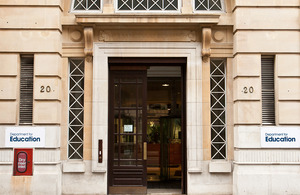Government tackles postcode lottery of school technology
Every school to have reliable, safe tech in classrooms as government rolls out plans for the future of digital standards to ensure no child is left behind

Pupils and staff across the country will have access to reliable, safe technology in their classroom as the government announces plans to help narrow the digital divide in schools - making outdated systems and patchy connectivity a thing of the past.
Across the country there are stark inequalities where some pupils suffer from basic digital access whilst others benefit from cutting-edge technology, including AI – creating unfair barriers to learning and future opportunities.
Following consultation with schools, the government is today (16 July) setting out expectations for schools and colleges to meet six digital standards by 2030, helping to end the postcode lottery in access to tech that has left too many pupils behind, by preventing teachers from delivering modern lessons and stopping pupils developing digital skills essential for modern careers.
The six standards cover broadband internet, wireless networks, network switches, digital leadership, plus two safety requirements: cyber security and filtering and monitoring to keep pupils safe online.
Online safety is at the heart of the government’s plans, with the cyber security and filtering and monitoring standards designed so that as digital access improves, school IT systems are protected from cyber security threats and the risk of online threats – ensuring technology enhances children’s education.
To support schools, the government will expand its Plan technology for your school service to give every school tailored support and guidance on how and where to make lasting, cost effective improvements to their technology.
This comes alongside a £45 million investment from government this year to boost school infrastructure, including upgrades to fibre and wireless networks – helping get classrooms online and boosting standards where it is most needed.
Minister for Early Education, Stephen Morgan, said:
Every child deserves access to the digital tools that will prepare them for the modern world, regardless of which school they attend. For too long, we’ve seen a postcode lottery where some pupils thrive with cutting-edge technology whilst others are held back by outdated equipment.
Meeting our six digital standards will ensure that by 2030, all schools have the digital provision they need. We’re investing in our children’s futures, supporting pupils to get the digital access they need to succeed whilst keeping them safe online.
This is a key part of our Plan for Change - ensuring every child has the chance to reach their full potential and no pupil is left behind in the digital age.
The Plan technology for your school service helps schools understand their bespoke technology needs, create digital strategies fit for the future and save money with guidance to enable them to strike the best deal possible with suppliers.
Jisc will also continue to support colleges with expert advice on the use of technology and access to Janet, the UK’s National Research and Education Network.
Evidence is clear that access to technology can boost a student’s attainment and meeting the standards will ensure every school has the digital infrastructure to deliver the technological support for staff and pupils for years to come.
The work forms part of the Government’s wider plan to break down barriers to opportunity, as too many pupils currently miss out on digital skills that are essential for modern careers, creating lasting disadvantage and impacting their future. The Connect the Classroom programme has so far improved connectivity for more than 1.3 million pupils in 3,700 schools.
By ensuring schools have reliable, safe technology, the Government is giving pupils - regardless of their school’s location or resources - the digital foundation they need to succeed in education and beyond.
Schools will work towards meeting the standards by 2030, with government support to ensure no pupil is left behind in the digital age.